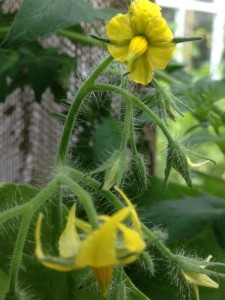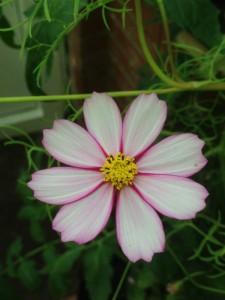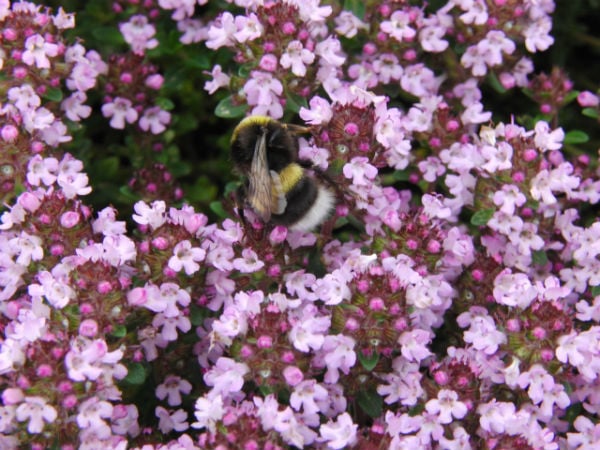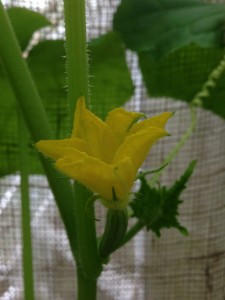 OK, it’s bees again, but not just honeybees, this time it’s bumblebees and solitary bees too. Without these little heroines (sorry chaps but it really is the girls that do that work), we would have a real dearth of food on our plates and the classic quote, always attributed to Einstein, but in my opinion wrongly, is that if the bees die out the planet will die within 4 years. Certainly we’d be in serious trouble, but if you believe what the garden chemical industry tells us, i.e. without pesticides we’d have a third less produce, then maybe it will be OK if we keep drenching everything in chemicals. Personally I don’t, which is why I don’t use any pesticides in my garden and greenhouse.
OK, it’s bees again, but not just honeybees, this time it’s bumblebees and solitary bees too. Without these little heroines (sorry chaps but it really is the girls that do that work), we would have a real dearth of food on our plates and the classic quote, always attributed to Einstein, but in my opinion wrongly, is that if the bees die out the planet will die within 4 years. Certainly we’d be in serious trouble, but if you believe what the garden chemical industry tells us, i.e. without pesticides we’d have a third less produce, then maybe it will be OK if we keep drenching everything in chemicals. Personally I don’t, which is why I don’t use any pesticides in my garden and greenhouse.
What the chemical manufacturers have apparently forgotten in their calculations is that the insects play a vital role not just in pollinating, but also as part of the food chain too. Think about all the creatures that eat insects; birds, bats, frogs, toads, hedgehogs and even fish! Without the insects that the chemical companies strive to annihilate, many creatures have no food; if we kill all the pests (and don’t forget that pesticides can’t tell the difference between an aphid and a ladybird) then we remove a massive section of the food chain, which brings the whole system crashing down. Messing about with the natural balance is not clever and the consequences have catastrophic potential.
So, my advice is to use common sense, grow your own and live and let live. So the sawfly eat your gooseberry bush, it’s unlikely to die and it’s not the end of the world. Put it into perspective. There are always crop failures each year, concentrate on the successes rather than the failures and learn from nature.
The Productive Greenhouse
 The July greenhouse is bursting with produce. It’s like opening the door into a living greengrocers, fragranced with the spicy scent of coriander flowers and simply dripping in juicy fruits ready to harvest in every direction. Some of the veg just grows and grows, producing rich, lush bowls of sumptuous fresh leaves perfect for salads and summer feasts. Then there are the self fertile crops such as the French beans, now covered in masses of crisp, crunchy, pencil thin pods and the cucumbers which are so prolific they are hanging off the stems like little green bottles of cool, juicy taste explosions and even the tiny cocktail kiwis, the Cucamelons, clambering up the hessian shading are forming weeny little melon shaped fruits that promise a bumper early autumn harvest. It’s looking like a promising summer for homegrown produce of every shape and flavour.
The July greenhouse is bursting with produce. It’s like opening the door into a living greengrocers, fragranced with the spicy scent of coriander flowers and simply dripping in juicy fruits ready to harvest in every direction. Some of the veg just grows and grows, producing rich, lush bowls of sumptuous fresh leaves perfect for salads and summer feasts. Then there are the self fertile crops such as the French beans, now covered in masses of crisp, crunchy, pencil thin pods and the cucumbers which are so prolific they are hanging off the stems like little green bottles of cool, juicy taste explosions and even the tiny cocktail kiwis, the Cucamelons, clambering up the hessian shading are forming weeny little melon shaped fruits that promise a bumper early autumn harvest. It’s looking like a promising summer for homegrown produce of every shape and flavour.
But, it’s the plants that need pollinating that are causing a bit of a worry. While the greenhouse is not a sealed entity, the automatic vents creating top access and exit during the heat of the day and the door and front windows are wide open for the midsummer sun, it’s not open all hours and pollinator activity can be restricted. Most of the plants that need insect pollination are planted outside now, but a few, such as the jungle of tomatoes jostling for light and space and flowering their little hearts out, well they need some extra help in the pollination department.

Fortunately the greenhouse air is alive with hoverflies, foraging bumbles and the odd honeybee attracted by the pollen rich flowers that abound. The courgettes can be hand pollinated easily and I do like to give the tomatoes a helping hand from time to time to ensure a bumper crop. Brushing the open flowers of as many tomato flowers as possible on the same plant in quick succession helps to spread the pollen around, but the best pollinators for tomatoes are the bumblebees. That’s because the pollen in tomato flower anthers needs movement to release it. Bumblebees harvest the pollen to feed their developing babies and once they have landed on an open tomato flower they vibrate to release the pollen grains, which drop out onto the bees underside. Most of the pollen is then carefully combed and collected into pollen baskets located on the bee’s hind legs. Look closely and you can see little balls of yellow or orange pollen on their back legs. As the bee hops from flower to flower any stray pollen on their bellies, is transferred to other flowers.
 It’s a magical process that’s so effective and efficient that we cannot possibly reproduce it. Bumblebees are so good at it that commercial strawberry and tomato growers buy bumblebee nests for their polytunnels to ensure a good harvest. Many (but not all) of these colonies are imported and are not native UK bumblebee species. As a result they have to be contained within the glasshouse/polytunnels so that they do not contaminate the UK population with any diseases or pests that they carry and at the end of the season the nests have to be destroyed. Some bumblebees do inevitably escape and this insect slave labour raises even more issues, not least the question whether commercial strawberries and tomatoes pollinated in this way can be deemed to be suitable for vegans. But that’s another story for another day, but definitely food for thought.
It’s a magical process that’s so effective and efficient that we cannot possibly reproduce it. Bumblebees are so good at it that commercial strawberry and tomato growers buy bumblebee nests for their polytunnels to ensure a good harvest. Many (but not all) of these colonies are imported and are not native UK bumblebee species. As a result they have to be contained within the glasshouse/polytunnels so that they do not contaminate the UK population with any diseases or pests that they carry and at the end of the season the nests have to be destroyed. Some bumblebees do inevitably escape and this insect slave labour raises even more issues, not least the question whether commercial strawberries and tomatoes pollinated in this way can be deemed to be suitable for vegans. But that’s another story for another day, but definitely food for thought.
For me, it just makes me very aware that every morsel of food produced in my greenhouse and garden is precious and every pollinator that enhances that harvest should be supported and protected as much as possible. Gardeners and greenhouse growers can do their bit by growing their plants from seed and choosing open, pollen and nectar rich flowers, such as cosmos, borage and echinacea to grow indoors and out. Bees trapped under glass can feed on the nectar and survive the night until they find their way out the next day. Learn some more about these precious creatures and cherish each and every one you find. For a quick bumblebee rescue remedy, make up a 1:1 sugar solution and offer a drop or two to exhausted bees that you find trapped in the glasshouse. They will revive quickly and can be released outside to find their way back to their nest.


